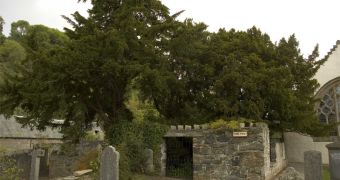Since ancient times, people associated the idea of the immortality of the soul, rooted in Plato's teachings, with evergreen plants. With a right trunk, arched branches and fusiform treetop, the cypress tree is generally recognized as the funerary tree in the Mediterranean area. In antiquity, this tree, always green and with a large lifespan was dedicated to god Pluto, lord of Hell. Its funerary symbolism comes from the classic myth of Cyparissus (Greek for "cypress"), a beautiful young man loved by god Apollo.
The boy had grown a deer, but one day unwittingly killed it and desperately asked Apollo to do something that would allow him to remember the lost animal for eternity. The god transformed it into a cypress. The tree turned into the symbol of the death and melancholy. The Romans were the ones to generalize its use as a graveyard adornment tree.
In Wales, the yew is the symbol of the immortality of the soul, and this comes from pre-Christian beliefs and customs of the Celt druids. Yews were planted around pagan temples much before the Christian times, being later adopted by the Church as a "holly symbol". Still today, yews are planted in British graveyards.
Yews have a height of maximum 10 m (33 ft) and grow very slowly. Larger individuals are just two or more trunks growing united through fusion. In this case, they can have circumferences of up to 17 m (57 ft).
Yews can live hundreds and some say thousands of years, some old British yews being the only survivors of medieval villages, around which new settlements developed. Yews are gymnosperms (cypresses, too) and do not form a fruit; still, the seed is wrapped in an aril, a light red fleshy cover which is the plant's only non-toxic part. Cattle eating yew seeds, leaves or bark will dies. Once it was said that if a house was adorned with yew, a member of the family was going to die.
The finely granulated yew tree resembles mahogany wood, being red-orange and resistant, suited for furniture. Due to its resistance and elasticity, in the medieval times, they were used for making bows. Oetzi, the Ice Man, a frozen mummy 5,300 years old found in the Alps in 1991, had a yew bow. Inside the skeleton of a mammoth discovered near the German locality of Lehringen, scientists discovered the oldest spear ever, made of yew wood 85,000 years ago.
Graveyards are dominated by yews both in UK and French Normandy. Yews were planted in couples, one at the covered gate, the funerary entrance to the graveyard, and the other near the church's door. The funerary way was sometimes delimited by two rows of cut Irish yews, and close to the high tombs, other yews were planted.

 14 DAY TRIAL //
14 DAY TRIAL // 
